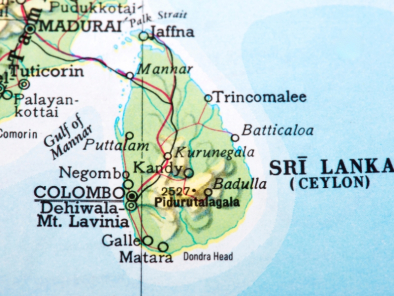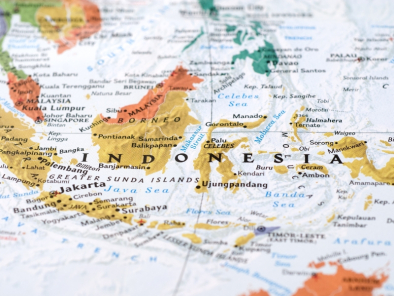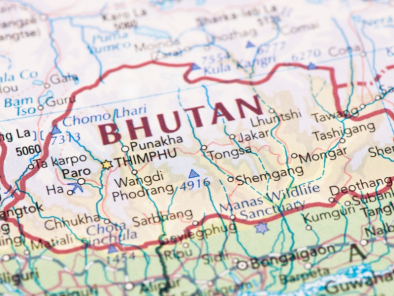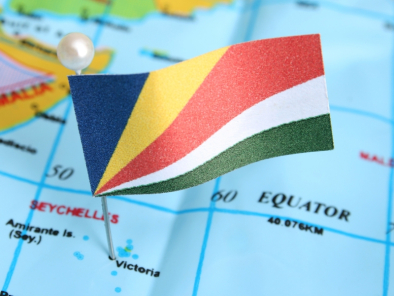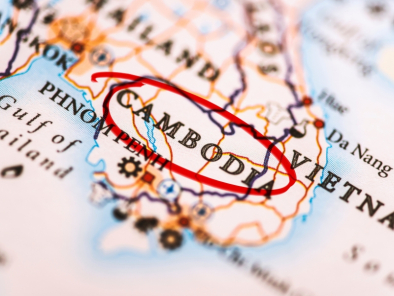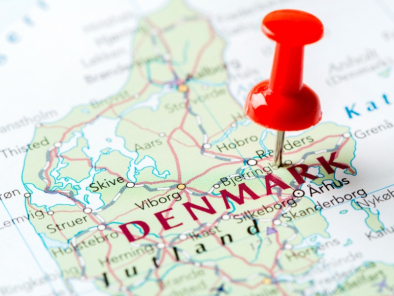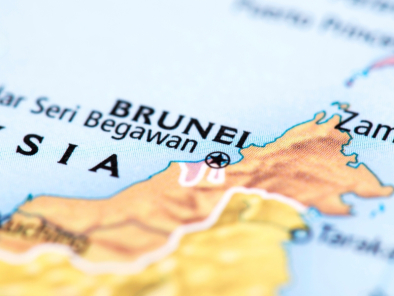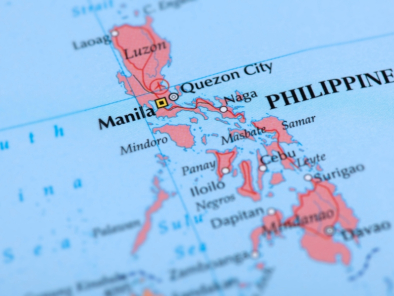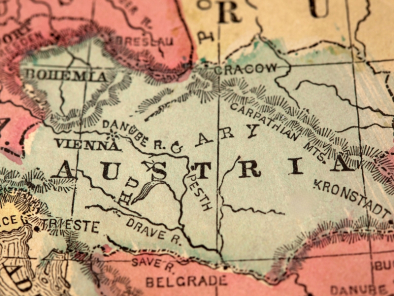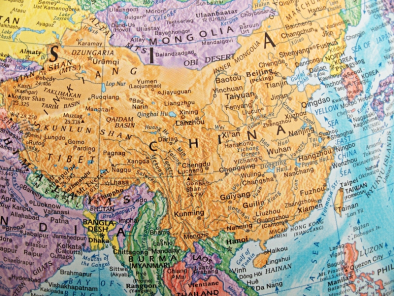SRI LANKA
Sri Lanka, the tourist literature will
tell you, is "a land like no other", and this is no idle boast. Lying
just off the south-east coast of India, with its southern tip barely
30km from the equator this is a tropical island that for centuries has
attracted the covetous gazes of people from all over the world. Rightly it
deserves its earlier appellation as "pearl of the orient".
VISA
REQUIREMENTS: Visa is issued on arrival for
Indian Passport holders
Please note above are the standard documents that
the Consulate usually ask for, in case they require any more documents or
clarifications we shall let you know. Please bear with us as we have no control
on the requirements for the Visas.
LANGUAGES:
The two official languages in Sri Lanka are
Sinhala and Tamil. However, English is widely spoken in important tourist
centers
TIME ZONE:
Same as IST
HOW TO GET THERE:
By
Air: Sri Lankan (UL), Indian Airlines (IC), Jet Airways (9W) fly directly into Colombo.
Most
International Carriers like Emirates, Cathay Pacific, Thai Airways, Singapore
Airlines etc fly into Colombo etc.
CURRENCY:
Srilankan
Rupees
The
US and Australian Dollars, Yen and British Pound are also accepted in the
larger shopping centres. In large shops, particularly the roadside arts and
craft centres that serve the passing tourist trade, you should have no problem
using international credit or debit cards. American Express, MasterCard and
Visa are the most commonly recognised cards, and any debit card with a visa
facility will usually be accepted. Traveller’s cheques can be cashed at banks
or licensed moneychangers and at selected hotels. Banks are open daily, but
some do not do foreign exchange on Saturdays. Indian Rupees is also widely
accepted in this Island nation.
Tipping
is a way of life in Sri
Lanka. It is advisable to obtain a bundle of
small denomination notes as soon as possible for the purposes of handing to
waiting staff, hotel porters and the like.
CLIMATE:
Due
to its proximity to equator Sri
Lanka has typically tropical climate. There
are no marked seasons. The weather in plains and the coastal areas is hot and
humid with an average mean temperature of 27° C. Relative Humidity varies from
70% during the day to 90% at night. The cooling sea breeze moderates the
temperature. The hills are cool and pleasant with an average mean temperature
of around 20° C.
Sri Lanka is blessed with abundant
rainfall. The south-west monsoon brings rain mainly from May to July to the
western, southern and central regions of the island, while the north-east
monsoon causes rains in the northern and eastern regions in December and
January.
Best Time to
Visit Sri Lanka
Best
time to travel to Sri Lanka
is between the main rainy seasons. The period from November to April is the
driest season on the south west coast and up in the hills. Here, some of the
best beaches and many other places of tourist interest are located. Therefore,
period between November and April is the best time to visit this region and
this period is also considered as tourist season in Srilanka. May to September
is the best time to visit east coast, as it is dry during this period. Hence, Sri Lanka is
round-the-year destination-there is always a good time to visit at least some
part of the country.
CLOTHING:
ELECTRICITY: The electrical current is 240
Volts, AC 50 Hz.
Since
voltage tends to fluctuate quite often in Sri Lanka, it is safer to bring a
stabiliser if you are going to be using sensitive electronic equipment. Two and
three pin round plugs are used widely. However adapters are readily available
at electrical stores. In case you lose your adapter or forget to bring it, you
could even have a local electrician attach a new plug.
Distances between
important places in Kilometres:
|
City
|
Col
|
Kan
|
Anu
|
Dam
|
Gal
|
Nuw
|
Pol
|
Rat
|
Tri
|
|
Colombo
|
•
|
116
|
206
|
148
|
116
|
180
|
216
|
101
|
257
|
|
Kandy
|
116
|
•
|
138
|
72
|
232
|
77
|
140
|
142
|
182
|
|
Anuradhapura
|
206
|
138
|
•
|
66
|
322
|
216
|
101
|
240
|
106
|
|
Dambulla
|
148
|
72
|
66
|
•
|
264
|
150
|
68
|
174
|
109
|
|
Galle
|
116
|
232
|
322
|
264
|
•
|
290
|
332
|
150
|
373
|
|
Nuwara
Eliya
|
180
|
77
|
216
|
150
|
290
|
•
|
217
|
148
|
259
|
|
Polonnaruwa
|
216
|
140
|
101
|
68
|
332
|
217
|
•
|
241
|
129
|
|
Ratnapura
|
101
|
142
|
240
|
174
|
150
|
148
|
241
|
•
|
283
|
|
Trincomlaee
|
257
|
182
|
106
|
109
|
373
|
259
|
129
|
283
|
•
|
MUST SEES:
ANURADHAPURA
The
ancient city of Anuradhapura was the first
capital of Sri Lanka.
Founded in 500BC it saw the reign of 103 kings before the capital was moved to
Pollunawara in 1073. Nowadays a sprawling complex of ruins it still contains
several important Buddhist sites and remains a place of pilgrimage for Sri
Lankans.
The
holiest site is the Sri Maha Bodhi, the sacred bo tree. Grown from a sapling
brought to Sri Lanka
by Sanghmitra, sister to Mahinda, it is the oldest documented tree in the world
at some 2,200 years. The Great Stupa nearby is one of the largest in Sri Lanka
still in good condition, and includes a small temple containing several statues
depicting the various incarnations of Buddha. Between the bo tree and the stupa
you pass the remains of the Brazen Palace - now only 1600 stone columns stand
where there was once a seven-storey, 1,000 roomed building, the largest
building in the world of its time.
Elsewhere
in Anuradhapura you can see the remains of King
Mahasen's Palace with its well-preserved moonstone, the twin ponds where monks
used to wash and bathe and Thuparamaya,
Sri Lanka's
oldest dagoba and believed to contain the shoulder bone of the Lord Buddha.
Jetavanaramaya is also worth seeing - the largest stupa on the island its
dimensions make it the second biggest monument in the world behind the Great
Pyramid at Giza.
North-central Sri Lanka.
MIHINTALE
Near
to Anuradhapura is Mihintale, where Mahinda -
the son of the Indian king - first met the Sri Lankan monarch, and thereby
brought Buddhism to Sri
Lanka. Built around a small hill at the base
are the ruins of the monastery that was built here in honour of the auspicious
occasion. Interesting sights here include the massive stone trough that used to
contain rice and food for over a thousand monks and the lion statue shower,
where the monks washed. You can also still see the stone tablets inscribed with
the rules and regulations of the monastery for both monks and non-monks.
Further
up the hill you find the Cobra Pool, the bathing and recreation pool the monks
used. On the shoulder of the hill is a large stupa, while on the saddle you'll
find a small monument depicting the exact spot that Mahinda and the king are
thought to have met. If you have a head for heights you can climb the narrow,
barely-there steps to the top of the rocky outcrop that forms the summit. This
hill is known as "the rock of invitation" from where the novice
Sumana invited people to come and hear the first sermon of Mahinda. Views from
the top looking back to Anuradhapura
are well worth the climb.
POLONNARUWA
The
second capital of Sri Lanka,
Polonnaruwa is a lot younger than Anuradhapura
and contains better preserved relics. The city was Sri Lanka's capital for only 200
years or so, from the 11th to the 13th centuries, but possessed a marvellous collection
of palaces, temples and statuary - much of which still stands today.
It
takes a full day to see all the sights that Polonnaruwa has to offer but the
undoubted highlights for most people are the marvellous Buddha statues carved
from the cliff face at Galvehera. Also known as the "Cave of the Spirits
of Knowledge" the three statues of Buddha, one standing, one meditating
and one reclining, are amazing examples of the ancient art of stone carving.
Other
sites you should visit in the area include the Royal Palace of King
Parakramabahu I, one of the first rulers in the 11th century. The outer walls
of the main hall still remain standing, although the wooden upper-storeys have
long since crumbled to dust. More impressive still is the ruined Lankathilaka,
a massive image house containing a headless figure of Buddha. The only fully
intact building is the Shiva Devale, a Hindu shrine containing some bronze
statues. There is also an archaeological museum on site where you can see some
of the various finds.
DAMBULLA
CAVE TEMPLE
Even
among the many fabulous Buddhist statues and temples in Sri Lanka, the
caves at Dambulla are considered the finest preserved. They date from 1301 and,
according to legend, were all constructed by one man, the exiled King Valagam
Bahu.
Situated
halfway up a small hill the temple consists of three natural cave chambers.
Within you can see a series of identical Buddhas. The legend of Dambulla
records that the king built one for each of the 14 years he was exiled here, as
a penitential calendar, although nowadays there are substantially more statues
to be seen. A large 14m long expiring Buddha dominates one side of the main
chamber.
As
you leave you can hardly miss the giant Buddha statue that sits at the base of
the hill above the Chinese restaurant-like visitor's centre. It is notable as
being the only Buddha in the world in the "argumentative" pose.
SIGIRIYA ROCK
FORTRESS
As
any guide or guidebook will tell you, Sigiriya Rock Fortress is the
"eighth wonder of the world". Although it's a name awarded to many
places around the world, for once this isn't undeserved hyperbole. Built by
King Kasyapa in the 5th century, the fortress sits atop a single rock, which
rises 500ft sheer from a vast expanse of surrounding rainforest.
You
approach the rock along a thoroughfare that was once lined with pools and
fountains, once a huge pleasure garden where the king and his entourage would
take their leisure in opulent surroundings.
From
here a flight of stairs proceeds between two boulders, which form the
"lion gate". Halfway up is a surviving section of the original
staircase that once wound its way across the cliff face. It is completely
enclosed by a wall known as the Mirror Wall some eight feet high and once highly
polished to reflect and still adorned with ancient graffiti. From here you can
climb an additional staircase to access a tiny cave, filled with frescoes of
semi-naked women. Once there were over 200 such paintings in caves on the cliff
face, but the Buddhist monks that inhabited the fortress in latter years had
them destroyed as they were too distracting.
The
lion plateau forms the shoulder of the rock. From here the ancient staircase
proceeds between two gigantic brick lion's paws, once part of a sculpture
consisting of a lion's head and shoulders, with the gaping jaw forming the
entrance to the stairs. A final vertiginous climb brings you to the summit,
where you can see the foundations of the nine-storey palace that once stood
here. The king's stone throne and the swimming pool, fed by an ingenious
windmill system of hydraulics from the reservoir far below, are still intact.

KANDY
Kandy is Sri Lanka's second city and the
cultural capital of the Hill Country. In itself it is a vibrant town, more friendly
than frenetic Colombo,
while its history means that this is one of the most revered towns in the
country. This was the last home of the Sri Lankan kings and its many fine
buildings bear testament to its status as royal city. It is oriented around a
massive central lake, built by Sri Wickrama Rajasinha, the last king to rule
here. You can still see the ruins on the island in the middle, which according
to local rumour was where the king would invite his favourite handmaidens to
come "bathing" with him.
The
Temple of the
Tooth stands just by the lake. Kandy's premier attraction, it contains Sri
Lanka's most valuable Buddhist relic, a tooth of Lord Buddha, smuggled from his
funeral pyre and carried to Anuradhapura in secret. Twice daily the tooth (encased
within its golden receptacle) is revealed to the devout. The shrine room and
the stuffed remains of Raja, an elephant that served the temple for 50 years,
can be seen here. If you're in Kandy
in July you may see the Esala Perahera, a huge pageant that sees the tooth
paraded around the city on elephant back.
SINHARAJA FOREST RESERVE
The
most famous nature reserve in Sri Lanka
the Sinharaja Reserve is a UNESCO world heritage site and is rightly one of the
must-sees for any visitor interested in Sri Lanka's natural as well as
cultural heritage.
Located
in the south-west of the island the reserve covers an impressive 20,000
hectares. Within its expanse you can find all the diversity of Sri Lanka,
whether plant, animal or insect. More than half of the plant and animal life is
indigenous to the island, and of that there are several unique species that
aren't found anywhere else on earth.
The
reserve is one of the few parks in the country where you are allowed to trek on
foot, although you should keep an eye out for leeches who thrive in the humid
conditions and latch on to any unsuspecting ankles that come along. More
interesting is the myriad colourful birdlife, and the great many large mammals
you can see within the reserve, including bats, boar and big cats. You can also
expect to see reptiles, snakes, large spiders and other insect life, which
might be less welcome.
The
best point to enter the park, and the most easily accessible from Colombo, is Kudawa, in
the north-west of the park.
PINNAWELA
ELEPHANT ORPHANAGE
The
elephant orphanage, founded in 1975, is a charitable organisation originally
funded by the government who were prompted into action by the high number of
lone baby elephants orphaned by increased hunting levels. Since the initial
group of five elephants the sanctuary has grown remarkably, and there are
currently over 70 animals under its protection. The orphanage has also moved
several times, as it has constantly outgrown its previous homes.
The
current location at Pinnawela near to Kigalle is extensive enough to allow the
animals to roam relatively freely, forming their own herd groups and behaving
largely naturally. Twice a day the animals are watered in the river and the
younger animals are bottle-fed milk, always the most popular visiting time for
tourists. The orphanage also boasts plenty of craft shops selling leather,
batik and wood carvings.
COLOMBO
It
is a sprawling expanse that mixes colonial influences with ultra-modern
edifices, and although it can be frustrating and crowded at times, it is always
fascinating.
Colombo is split into several separate
parts. The central area is Fort (where the Dutch originally had their main
stronghold in Sri Lanka)
and the Pettah. The massive towers of the World Trade Centre makes it easy to
locate these two neighbourhoods, although the town below these modern edifices
is completely at odds with their gleaming appearance. Fort is a slightly
rundown maze of ex-colonial buildings and banks, while the Pettah is a crowded,
crumbling district of narrow streets, packed with hawkers and shoppers. The Dutch History
Museum here contains
plenty of artefacts from the days of colonial rule and is worth a look.
Elsewhere in the city you can find the modern attractions of
the Galle Road,
lined with hotels, malls and Western style stores. Nearby you'll find the
excellent National Museum, housed in a colonial style mansion and packed
with treasures from Sri
Lanka's many historical sites. Places of
interest in Colombo are Vihara Maha
Devi Park
and the colonial style brilliant white Town Hall; the Museum which houses many
rare treasures; the parliamentary complex at Sri Jayawardhanapura, the
administrative capital, a unique work of architecture set on an island. The
Bandaranayake Memorial International Conference Hall with its spacious gardens
and right opposite is the colossal statue of Lord Buddha. Galle Face Green; the
Zoological Gardens – reputed to be one of Asia’s
finest; handloom & handicraft shops.
GALLE
The
capital of the south coast, Galle
is a charming colonial-era town. Established by the Dutch as a coastal fortress
it still retains a lot of that nation's laid-back attitude, and is considered
more relaxed than the rest of Sri
Lanka.
Popular
with sun seekers it sits at the heart of Sri
Lanka's best beaches, and up the coast, between here and Colombo, you'll find the
island's largest resort complexes. Naturally the sands and warm ocean are a
tempting draw, but it's worth taking time out from topping up your tan to
explore Galle itself.
The 17th-century Dutch Fortress is one of the best surviving examples of that
particular era in Sri Lanka's
colonial history. The National Maritime Museum
located here is a small collection of artefacts relating to Galle's nautical and fishing history. The
coast here is very popular with divers, the warm clear waters are littered with
17th-century wrecks of Dutch merchant ships from when Galle was an important spice port. Surfers
head for the nearby resort of Hikkaduwa, while those wanting to laze on the
beach will find plenty of white sand and clean waters at Unawatuna.
NUWARA ELIYA AND
THE TEA PLANTATIONS
Head
for the hills in central Sri
Lanka to see the country's most famous
export, tea. Starting from Kandy the tea plantations carpet the slopes of the
mountains, rising all the way up to the highest points on the island, well over
2,000m in height. Designated lower, middle or high grown the cooler climate and
steady rainfall is ideal for growing the hardy plant, first introduced by the
British in the 19th century.
Tea
plantations litter the mountainsides and along the road between Kandy and Nuwara Eliya
you'll find several offering tours and demonstrations of the tea-making process
- the largest is the Labookellie factory owned by Mackwoods, but there are
plenty of others.
Sri
Lankans refer to the charming town of Nuwara
Eliya as "Little England". At 2,000m above
sea level the climate here is similar to that of the European nation, and it is
no surprise that many British chose to build their homes here when they settled
in Sri Lanka.
The town contains many examples of British colonial buildings, and even a golf
course. Staying in one of the many old-fashioned hotels, waited on by
immaculately white-coated attendants, it is easy to transport yourself back to
the days of colonial rule.
RATNAPURA
The
"City of Gems", which has a reputation
for producing some of the world's finest gems, is just one and a half hours
away from Colombo.
Visit the gemming area, panning of gems, watching men at work with their
age-old customs and rituals. Experience the thrill of unearthing a priceless
treasure. Visit a gem cutting and polishing centre and the gem museum. View an
exhibition of Sri Lankan Gems. Visit the gem museum where you could see a
scaled down model of a typical gem pit, showing the different strata of rocks.
They will also demonstrate the equipment for the various stages of polishing
and cutting of a gem. You will see the transformation of a small stone plucked
out of earth, to the sparkling status symbol on your finger.
BENTOTA
Bentota
is a famous beach resort at a distance of 62 km to the south of Colombo. Located at the
junction of Bentota
River and the sea the
place offers plenty of water sport opportunities such as windsurfing,
water-skiing and catamaran rides. The best time to visit Bentota is between
October and April, when the sea is safest for swimming.
BERUWALA
Located
at 58 km south of Colombo, Beruwala takes an
hour's drive from Colombo
to reach. Beruwela marks the beginning of 130 km stretch of South Coast
beach resort. It is located close to the famous tourist spot of Bentota.
Beruwela is the first Muslim settlement in Sri Lanka, established by the Arab
traders in 8th century AD. There is a famous Muslim mosque at the beachhead
close to which is a lighthouse. Beruwela has excellent water sport facilities.
Beruwela offers good bathing facilities round-the-year.

HIKKADUWA
Located
98 km south of Colombo, Hikkaduwa is one of the
most popular beach resorts of Sri
Lanka. Sri Lanka's only marine sanctuary
is located here. It is an ideal place for nature lovers with its abundant
corals and tropical fishes. Hikkaduwa has something to offer to everyone-coral
for snorkellers, waves for surfers and white pristine beaches for those who want
to relax and enjoy Sun and sand.
SHOPPING
Most
famously Sri Lanka is home
to a thriving gem industry and almost every street (certainly in Colombo and the gem
capital of Ratnapura) has at least one jeweller. Traditional jewellery designs
aren't always to Western tastes, with overly large gems often used, however
some of the more respected jewellers are beginning to change designs to
encompass more progressive tastes. The pale sapphire is the island's most
distinctive stone but rubies, amethyst, garnet, cat's eye and yellow sapphire
are all widely available. It is possible to simply buy stones as well, which
can be set when you return home. Many larger jewellers offer small tours of
their workshops as well as the opportunity to buy.
Miscellaneous
items to look out for include brass ornaments, leather, silverware, spices and
of course tea. Tea factories and processing plants always have a shop selling
smart gift sets of top quality and flavoured tea but prices are more
competitive at supermarkets. You only need to buy the rarest varieties from
source.
Kandy is the best place to buy most
of the handicrafts produced in Sri
Lanka. There are number of shops catering to
the tourists. Markets such as Kandy's
large bazaar are the cheapest place to shop, but even here tourist prices will
be marked up. At Kundasale, about 4km
from Kandy, a
village has been established recently to settle local craftsmen and their
families. Visitors could watch artisans at work and purchase their products on
site.
Sri Lanka is a major garment
manufacturer and exporter of all kinds of clothing. Colombo is a major attraction for garment
hunters. One can buy excellent selection of children's wear, beach wear, casual
clothing for men and women and warm padded jackets at attractive prices from Colombo.
As
the producer of the world's finest teas there are many tea sales centers at
most tourist destinations around the country and at main shopping centers in Colombo.
If
you think something is grossly over-priced then imagine it in your local
department store and state what you think it would be priced there - it is
guaranteed to be far more than the vendor could expect to receive for the
piece. That way everybody gets a fair deal.
Opening
Hours
Shops
tend to open from around 09h00 until 19h00 or 20h00 each night. Many will close
in the middle of the day for a siesta. Markets and grocery stores may open
earlier.
